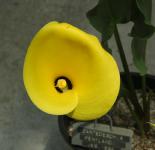Calla lilies, actually Zantedeschia vareties, are generally not hardy here planted outdoors. The exception seems to be when they are planted outdoors close to the walls of my greenhouse. I have a large clump of Zantedeschia 'Green Goddess' planted right against the foundation at the south end of the greenhouse, and a small clump of the dark red-brown 'Black Pearl' planted on its east side. Both have come back year after year.
There are more interesting plants that we keep in pots and carry over winter in the greenhouses. If we water them a bit in spring, they quickly start to flower in the greenhouse. Right now, the wild species Z. pentlandii is blooming with a large yellow calyx. One seems to be about 4 inches across the open end.

 Zantedeschia pentlandii, native to the Belfast district of Mpumalanga Province in South Africa. It grows in rocky places along mountain streams.
Zantedeschia pentlandii, native to the Belfast district of Mpumalanga Province in South Africa. It grows in rocky places along mountain streams.
Zantedeschia pentlandii is now available from several mail order bulb companies. However, I bought mine from Charles Craib in South Africa a few years ago, when no one else offered them anywhere. I think I got tubers at most ½inch in diameter. The leaves are solid green, and the flowers are quite striking when in bloom.
The white flowered Z. albomaculata has the same narrow, arrowhead shaped leaves as Z. pentlandii, but with white or translucent spots in them. It is another native from South Africa. This one is common in cultivation, and I have some I grew from seeds and others that I received as pass-along gifts from friends.
Another species is Z. rehmannii, which is probably the most cold-resistant species. It grows at very high altitiudes in South Africa. It has solid green leaves with an elongated, very narrow arrowhead leaf form. The flowers, whose narrow calyx is pink colored, are smaller than the other species. I suspect that this species is the ultimate ancestor of the red, pink, lavender, and "black" flowered Calla lily hybrids of commerce.
Irma likes black flowers, so we have two varieties of dark Calla lilies here: 'Black Forest', which we think is an American trade name for the European 'Schwarzwalder', and also 'Black Pearl'. We have not tried to cross pollinate these two varieties, since one of them blooms early in the summer and the other blooms late in summer. Both are attractive "black" Calla lilies, both have white spotted leaves, and between them they provide us with black blooms through most of the summer. A large tub full of these makes a very nice deck or patio specimen when in bloom.
The large white Calla lily, Zantedeschia aethiopica, is evergreen. 'Green Goddess' is a variety or sport of Z. aethiopica. I'm amazed 'Green Goddess' survives outside our greenhouse, since the cold weather kills it to the ground every winter.
Most of our Z. aethiopica are grown in 2-gal. to 5-gal. pots and are kept in the greenhouse over winter, with occasional watering. They tend to start blooming in January to March. They will rebloom sporadically during the summer, if we keep them well watered. I often grow these under dappled shade (in the lath house), while the others are kept in full summer sun.
One strain of Z. aethiopica we have has blooms with a light pink tint to the calyx. This is quite nice.
Good gardening,
Jim